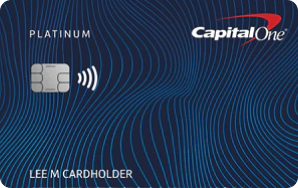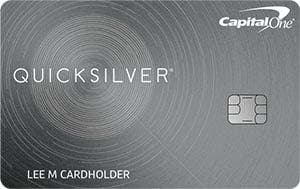Capital One Platinum vs. Quicksilver: Which card is better?
In a comparison between the Capital One Quicksilver Cash Rewards Credit Card and the Capital One Platinum Credit Card, the Quicksilver card is undeniably the better option. However, the decision between the two isn’t always that simple — these two Capital One cards are best suited for different types of consumers.
The Quicksilver card is geared toward people who have excellent credit and an established credit history. It provides a $200 welcome bonus, a generous intro APR offer and cash-back rewards. You might choose this cash-back card if your credit is strong and you want to earn rewards on a wide variety of purchases.
The Platinum card, with its relaxed eligibility criteria, has higher odds of approval for people who have fair credit. It doesn’t provide rewards or a welcome offer, but it does have a $0 annual fee. This card may be a good option if you want to improve your credit but don’t qualify for the Quicksilver card.
We’ll dive into the details of each card below, but here’s a quick overview of how the Quicksilver and Platinum cards stack up:
| |
Capital One Platinum Credit Card |
Capital One Quicksilver |
| Best for |
Individuals with fair credit |
Earning flat-rate cash-back |
| Welcome bonus |
N/A |
$200 after spending $500 in the first 3 months of account opening |
| Earning rewards |
N/A |
1.5% cash back on all purchases
5% cash back on eligible travel purchases |
| Annual fee |
$0 |
$0 |
| Other benefits |
$0 fraud liability
Credit score monitoring |
$0 fraud liability
Credit score monitoring
6 months of free Uber One membership
Intro APR offer |
| Eligibility |
Fair/good credit (580-740 FICO) |
Good/excellent credit (670+ FICO) |
| Learn more |
Read our Capital One Platinum review |
Read our Capital One Quicksilver review |
Capital One Platinum vs. Quicksilver: Welcome bonus
Winner of this category: Capital One Quicksilver
The Capital One Quicksilver Cash Rewards Credit Card comes with a cash welcome bonus of $200. You can qualify for this bonus if you spend $500 in the first three months the account is open.
This is a relatively average welcome offer for a cash-back credit card, but it might be appealing if you don’t spend much each month. To get the bonus, you need to charge slightly less than $167 per month for the first three months to meet the requirement — something that’s easy to do for most people. Use the card for gas and groceries, and you may be able to reach the threshold quickly.
In this category, the Quicksilver card is the clear winner — after all, the Platinum card doesn’t have a welcome bonus. As long as you can qualify for the Quicksilver and reach the spending threshold on time, this card is a better option.
Capital One Platinum vs. Quicksilver: Rewards
Winner of this category: Capital One Quicksilver
The Capital One Quicksilver card simplifies the rewards process. Every purchase you make earns 1.5% cash back. If you book hotels or rental cars through Capital One Travel using your card, you’ll earn 5% back. The rewards are unlimited, so there’s no cap on how much you can earn. Plus, they never expire — you might decide to allow the cash to accumulate and use it for a special treat down the road.
When it comes to redeeming your rewards, Capital One offers a variety of options. You can use them to pay down your card balance or to cover travel booked in the Capital One Travel portal. Alternatively, redeem your cash-back rewards for gift cards or pay for purchases through PayPal and Amazon. The rewards always have the same value, so redemption is a breeze.
With its straightforward earning structure, the Quicksilver card is useful for all types of consumers. When you travel, however, your earning potential rises dramatically. Book a $1,000 hotel stay through Capital One Travel, and you’ll automatically earn $50 in cash back. Plus, you can reduce the cost of your booking using the rewards you’ve already accumulated with this travel card.
Again, the Quicksilver card wins. As is the case with many entry-level credit cards, the Platinum card does not offer rewards.
Capital One Platinum vs. Quicksilver: Other benefits
Winner of this category: Capital One Quicksilver
Both the Platinum and the Quicksilver cards offer a set of standard benefits.
These benefits include:
The two cards also enable you to set up autopay for regular bills and access a list of recurring transactions at any time. This can be useful if you want to keep track of expenditures. It also makes it easier to identify streaming subscriptions and other memberships you’re not using.
As you might guess, the Quicksilver card includes a variety of useful perks. Once you sign up, Capital One offers six months of free Uber One membership. If you use Uber and Uber Eats regularly, this perk alone can save you a great deal of money with free delivery and discounted pricing. Quicksilver also comes with exclusive access to tickets and experiences through Capital One Dining and Capital One Entertainment.
For frequent travelers, the Quicksilver travel accident insurance and 24-hour assistance line can be useful in case of an emergency. If your card is lost or stolen while you’re away from home, Capital One can send you a quick replacement. They can even provide a cash advance to cover expenses in the meantime.
If you’re repairing your credit or learning how to build credit, the Platinum card offers a big perk: automatic credit line reviews. Starting at the six-month mark (later for some cardholders), Capital One will review your account and offer a credit limit increase if you qualify.
This is another aspect of the Capital One Platinum card vs. Quicksilver debate with a clear winner. While the Platinum card comes with a few perks, the Quicksilver card is a better choice.
Capital One Platinum vs. Quicksilver: Rates and fees
Winner of this category: Capital One Quicksilver
When it comes to fees, the Quicksilver card has a big advantage in the Capital One Quicksilver vs. Platinum comparison. For the first 15 months, you’ll enjoy an intro APR of 0%. That’s particularly attractive if you’re planning to make a big purchase. Use the card to buy a new computer or pay for a major car repair, and as long as you pay off the balance within the intro period, you won’t pay interest.
The Quicksilver’s intro APR also applies to balance transfers, but you will need to pay a transfer fee. After 15 months, the Quicksilver card offers a variable APR ranging from 19.99% to 29.99%.
By contrast, the Platinum card comes with a 30.74% variable APR. It does not offer an intro APR rate. The Quicksilver card will likely cost you less over the lifetime of the card, even if you qualify for the 29.99% APR.
The Quicksilver and Platinum cards are even in terms of additional fees. Neither card has an annual fee or foreign transaction fees, which can save you a great deal of money if you travel internationally regularly. And if you’re thinking about adding a loved one to your account, both cards allow you to add authorized users for free.
Capital One Platinum vs. Quicksilver: Eligibility
Winner of this category: Capital One Platinum
If you’re concerned about getting approved, the Platinum card has the advantage in the Capital One Platinum vs. Quicksilver card comparison. It’s designed for people with fair credit, which means that it’s easier to be approved — even if you have some negative marks on your credit report. In fact, Capital One specifically mentions that “fair” credit could include someone who has defaulted on a loan.
You might also consider this card if you’ve only started establishing your credit within the last three years. It can be difficult to get approved for rewards credit cards with a barely there credit profile, so the Platinum card offers a better chance of approval. Once you have the card, it’s possible to build a credit history and improve your odds of getting a premium card in the future.
The Capital One Quicksilver card, on the other hand, requires excellent credit. By Capital One standards, this means that you have never defaulted on a loan or filed for bankruptcy. You also need a history of on-time payments and a $5,000+ credit card or loan that is at least three years old.
Capital One doesn’t publish specific credit score requirements for these two credit cards. The company has mentioned that an excellent score is typically 781-850 and a fair score is 601-660. Your approval odds will likely depend on a mix of factors, including on-time payments, credit score and credit history age.
The Capital One Platinum vs. Quicksilver credit limit varies from person to person. In general, Capital One sets the limit after assessing your income, existing debt and credit profile. Given that the Platinum card is designed for cardholders with lower credit scores, it’s safe to expect a lower maximum credit limit.
Note: If you want the cash-back benefits of the Quicksilver card without the strict eligibility requirements, you may want to compare Capital One Platinum vs. QuicksilverOne. The QuicksilverOne card is suitable for people with fair credit. However, it doesn’t have an intro APR offer, and it comes with a $39 annual fee. You could also apply for the Quicksilver card for good credit or the Quicksilver Secured, which has zero annual fees but no welcome bonus.
Should I get the Capital One Platinum or Quicksilver card?
If you qualify for the Quicksilver card, there’s no question you should choose it over the Capital One Platinum card. While neither card has an annual fee or foreign transaction fees, the Quicksilver offers 1.5% cash back on all purchases, a 15-month intro period with 0% APR and lower interest rates after that. In contrast, the Platinum card has a higher interest rate, no rewards and no sign-on bonus.


































































































































